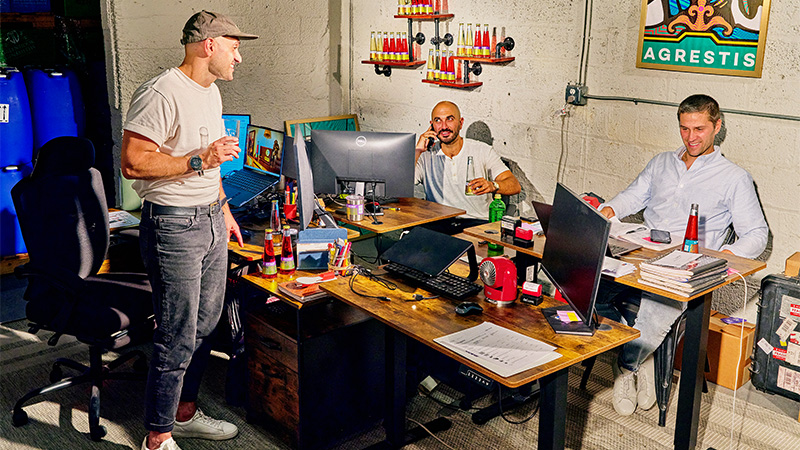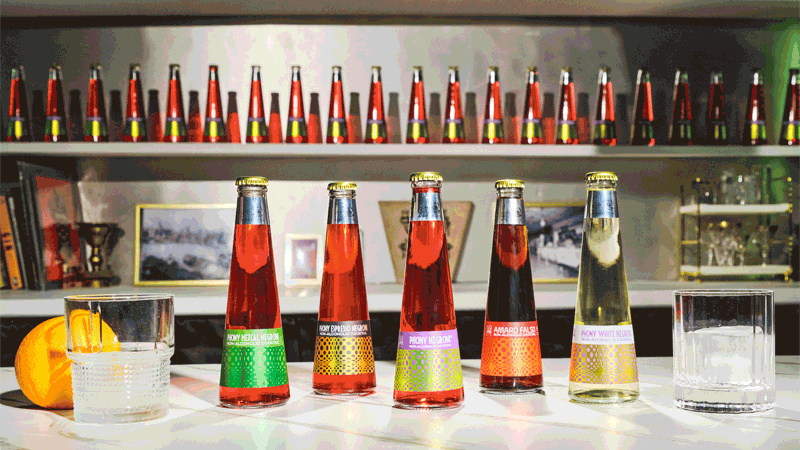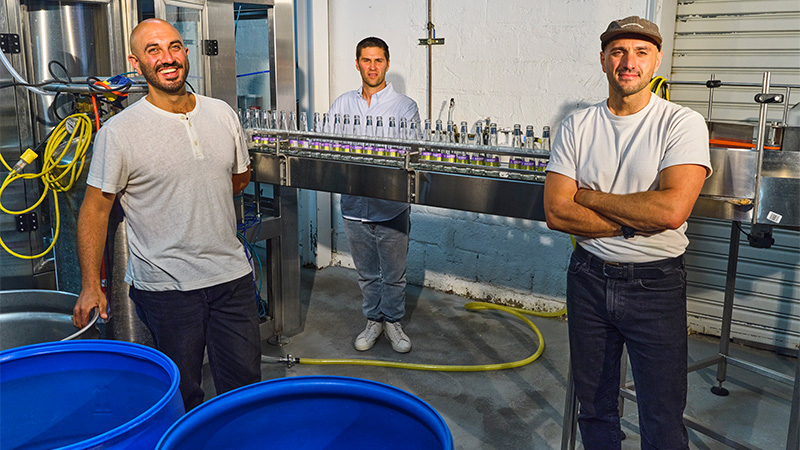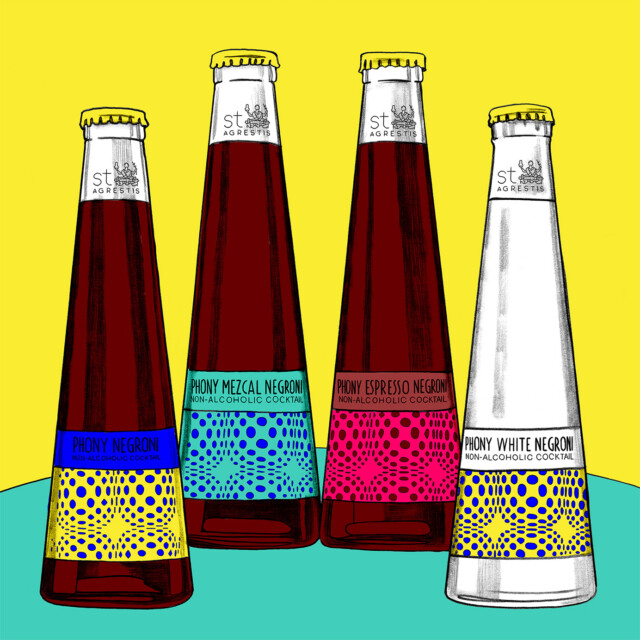St. Agrestis isn’t a non-alcoholic drinks brand in its entirety, but judging by the success of its cheekily named Phony Negroni, one might be inclined to believe it is. That’s likely due to the fact that, unlike most other brands producing both alcoholic and non-alcoholic products, the Phony Negroni is St. Agrestis’s top-selling SKU. And it’s taking the country by storm.
First established in 2014, St. Agrestis was originally founded by two New York City-based sommeliers — Nicholas Finger and Fairlie McCollough — who discovered their passion for amaro while traveling through Northern Italy. Once they returned to the States, they got to work developing St. Agrestis Amaro, a 30 percent ABV liqueur that served as New York’s very first contemporary amaro. But when Finger and McCollough pivoted their attention back to wine in 2017, the future of St. Agrestis was up in the air. Until Louie Catizone, Matt Catizone, and Steven DeAngelo swooped in, purchased the distillery, and relocated it from Gowanus to Greenpoint.
As sons of Italian immigrants, Louie and Matt were instilled with a lifelong love for amari and aperitivo culture. In the early 2010s, Louie connected with DeAngelo when the former was hired as one of the first employees at Greenpoint’s Greenhook Ginsmiths, a distillery DeAngelo founded in 2012 with his brother Philip. At Greenhook, DeAngelo worked tirelessly to source dozens of botanicals in order to craft the brand’s gins — efforts that proved to be fruitful when it came to producing amaro after the new co-owners purchased the distillery.
While the Phony Negroni might be St. Agrestis’s most successful product today, at the time of the purchase, producing a non-alcoholic product, let alone a non-alcoholic Negroni, was nowhere on their radar. But that all changed with a visit to Berlin in 2019.
“We had inspirations for aperitivi and cocktails beyond amaro, but none of them were conceptualized to be a knockout,” Louie explains. “The inspiration for the Phony came by way of a trip to Bar Convent Berlin in 2019. We had the spirit on the table then, but we noticed so much excitement around non-alc. So we came back and decided that we should probably research and develop a non-alcoholic Negroni.”

Naturally, determining how to craft a product that tastes like a Negroni and doesn’t feature any alcohol came with a few learning curves. As DeAngelo explains, alcohol is the solvent in herbal spirits like amaro, meaning that each botanical’s flavor is extracted by soaking in the high-proof liquid. Instead, they found success in breaking down the Negroni to its core flavors, which are botanicals, not spirits. Rather than crafting an NA gin, NA amaro, and NA vermouth, the team at St. Agrestis broke the Phony Negroni down to 33 botanicals.
“From there, we figured out how to layer and blend those 30 or so botanicals,” Louie says. “But blending those in the perfect ratio was really how we came to create the non-alc Negroni.”
Nailing the botanical aspect of the cocktail was only half the battle, though. Figuring out how to deliver the same weight and mouthfeel of an alcoholic cocktail was another hurdle the team needed to overcome. Sugar was one part of that equation — every bottle of Phony Negroni contains two servings, with 12 grams of sugar per serving. It’s an amount roughly equivalent to the amount of sugar one would find in alcoholic amaro, and it’s crucial for adding body to what would otherwise taste like a watered-down Negroni. The other variable in the equation proved to be slightly more unexpected: carbonation, which comes from both carbon dioxide and nitrogen.
“The carbonation aspect might be controversial, if you want to call it that, but we did it for a very specific reason,” DeAngelo explains. “To mimic the bite one feels at the back of their throat when they drink an alcoholic Negroni as opposed to the Phony tasting something like a non-carbonated soft drink. You drink those two things with totally different intentions.”

After several years of R&D, the Phony Negroni finally hit the market in January 2022, and it’s been going gangbusters ever since. By the end of 2023, St. Agrestis had sold over 1 million bottles of Phony Negroni. In 2024, that number practically doubled. In that time, St. Agrestis added three other variations to the Phony lineup: a non-alcoholic Mezcal Negroni, Espresso Negroni, and White Negroni. Part of that impressive growth can be attributed to the fact that, unlike most ready-to-drink beverages, the Phony Negroni performs well both off-premise (it’s stocked in retailers across the country) and on-premise in bars and restaurants.
In Louie’s view, this success can be attributed to the fact that it can be very challenging to craft convincing non-alcoholic versions of stirred cocktails. “If you put the three of us behind a bar tomorrow and told us to make a non-alcoholic Negroni, I don’t think we could do it,” he jokes. “We need all the equipment we have here, and the scale we do it on, to make it taste this much like a Negroni.”
Not only does this remove a barrier to entry for operators to serve guests reliable non-alcoholic cocktails, but it also cuts down significantly on the amount of labor required for them to do so. The packaging also doesn’t hurt. Every Phony Negroni arrives in an angular, custom glass bottle that shows the customer exactly what they’re drinking. Over the years, DeAngelo and the Catizone brothers have come to learn that, more often than not, Phonies are served in-bottle with a glass on the side, rather than pre-poured over ice. It’s a method that allows guests to rest assured that they’re not accidentally being served anything alcoholic.

“When it tastes good, a non-alcoholic cocktail can be a pretty scary experience for someone who is avoiding alcohol,” Louie explains. “The vessel ended up being a perfect solution to that. It’s a way for the guest to not be so anxious that they were maybe served something with alcohol.”
But perhaps one of the most important factors driving the success of the Phony Negroni is curiosity.
“I think the name is a really huge reason behind its success on-premise. We get a lot of feedback from customers saying they ordered the drink solely because the name was catchy,” Matt says. “They read it, they think ‘That’s a cheeky name,’ and they order it. I think the name hooks them, but it’s the quality that keeps them interested.”
This year, the brand is on track to achieve double-digit growth once more. According to DeAngelo, St. Agrestis has sold about 60,000 nine-liter cases of Phony Negroni in the past 12 months — that’s approximately 2.7 million bottles. And some major recent developments are sure to bolster those sales. In April 2025, the Phony Negroni officially made its debut across the pond, with the flagship product launching in the United Kingdom. While it’s too soon to draw any conclusions, early sales data from the market has been “very positive” according to the team.
Looking ahead, one of the things the Phony Negroni founders believe will be imperative to their continued success is remaining nimble and being able to react to trends. “We’re innovators and we’re bootstrappers. We don’t have to answer to anybody,” Louie says. “If we think something makes sense, we R&D it, we get the label created, we put it on the bottle, and we show it to the world.”
